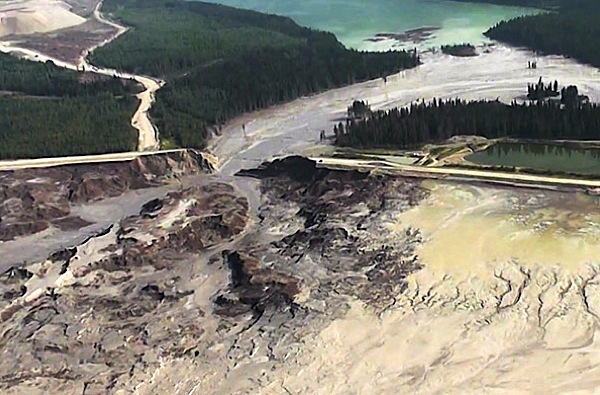
Aerial view of the Mount Polley mine tailings pond shows the area where the dam wall gave way early on the morning of August 4. (Image from archives)
Nine months after Canada’s Mount Polley copper and gold mine’s tailings pond breach, a new report has found a number of changes in the local ecosystem caused by the massive spill.
Researchers from the University of Northern British Columbia and the University of B.C., who studied the sediment plume of waste and water within Quesnel Lake in the three months following the incident, have concluded the water reservoir’s ecosystem has changed.
Among other anomalies, the report quotes a rise in the lake’s water level of 7.7 centimetres between Aug 4 and Oct 4, 2014, with the temperature at the bottom of the lake climbing from 1 to 2.5 degrees Celsius.
It also found higher levels of sediment — associated with an increase in turbidity in the lake.
Mine tailings were likely flushed from the lake into the Quesnel River, says the document, with huge amounts sinking to the bottom, which could leach over the years, the team said in a statement.
However, they believe it is still too early to determine long-term impacts on fish and drinking water.
Vancouver-based Imperial Metals (TSX:Ill), which operates Mount Polley, has said it could reopen the mine in June if granted a permit.
The company laid off 120 employees this week, according to The Williams Lake Tribune. The figure adds to the 36 who lost their jobs last November, and the 50 people dismissed in February.
8 Comments
Dan Meldrum
It is unclear from this report (or the abstract) as to when the readings (turbidity / water temperatures …) were taken. Were they taken several days after the accident or months afterwards?
If levels of turbidity and water temperatures remained high for many months – there may be reason for concern. If, however, they were high only immediately following the accident – it doesn’t seem as though there is as much concern for long term ill effects.
It is important to keep in mind that tailings are mostly crushed rock – some people have in mind that the entire volume of the material sent into the lake is some horrible toxic goo.
Dylan E McFarlane
This report is limited to 2 months postspill. Potential medium-long term impacts are not evaluated. According to MOE’s latest reports based on April sampling on the Quesnel, there is no direct evidence of adverse impacts as yet. Elevated turbidity, Al, and Fe have natural precedents with spring snow melt and Health Canada is reporting no adverse effects to water quality: http://www.env.gov.bc.ca/eemp/incidents/2014/mount-polley/pdf/20150429/Memo-Quesnel-River-and-Hazeltine-Creek-Feb-17-Apr-14-DW.pdf. Still, VERY fortunate these were not acid generating tailings, and that they spilled into an enormous, basically immobile, sink.
Dan Meldrum
Mining.com – thanks for the link to the more detailed report.
Dylan, Thanks for that. The title of this piece suggests that the Ecosystem is permanently significantly damaged. I was working my way through the full article and I couldn’t find anything that made the hair on the back of my neck stand up, The increase in water level seemed on the same order of magnitude as a heavy rainfall recorded later in the year.
Yes, very lucky that the tails were relatively benign. Definitely dodged a bullet there. Some tailings do have nasty bits in them.
Yodle
Sounds like some labs are not up to snuff?? Months to get results?
rayban
It shall take a while to understand the true nature of this spill . No excuses , better tailings control is needed . I would of course vote for dry stack tailings on as many future projects as it fits .
guest
Murray Edwards should be thrown in jail. He has a track record of environmental and safety crimes all over western Canada.
CDNJoe2
WOW! I worked at Giant Mine in Yellowknife as a teenager in the 1970’s. Google that Giant mess.
Drove through Britannia Beach between Whistler and Vancouver every day for years. The Britannia Mine site was 100 years old and flushed daily by Pacific Ocean currents in Howe Sound, yet all marine life within 3 miles was dead.
All of us as taxpayers are spending Billions of $$$$$ cleaning up this crap while mining company shareholders walk away clean with million$$$.
The marine life in the Quesnel watershed could prove too toxic to eat for 20 years, only time will tell.
Every dime from the Mount Polly operation should be frozen to pay for the damage. The shareholders should be held accountable.
International Free Trade Agreements allow companies to sue Canada for “the anticipated lose of potential profits”. Canadian taxpayers should be given the same right.
Clay McCann
Funny, I’m not hearing any discussion about the mercury, lead, selenium, and other really toxic-to-humans sludge that was in the tailings pond, now smeared along Hazeltine Creek, the bottom of Quesnel Lake, and the Quesnel River. Check Environment Canada’s National Pollutants Release Inventory data on Mt. Polley (NPRI 5102). You’ll find the former tailings pond was home to some pretty awful scudge before the collapse. And, as I say, isn’t it funny we never hear about this stuff in the ongoing, diverting discussion on turbidity in the “drinking water”.